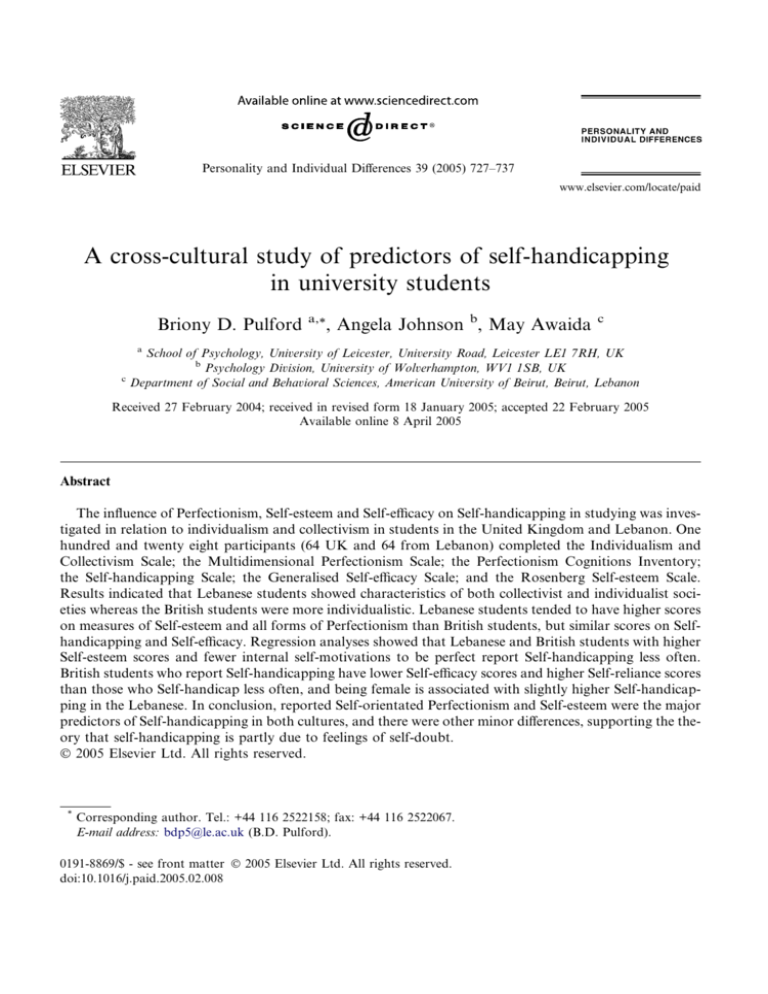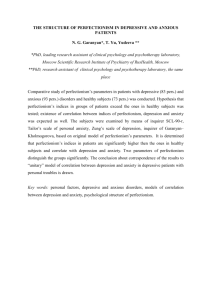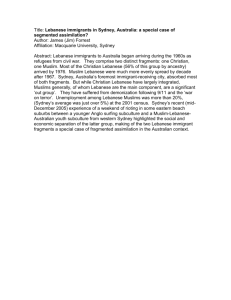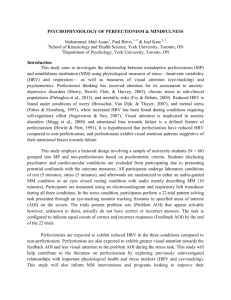
Personality and Individual Differences 39 (2005) 727–737
www.elsevier.com/locate/paid
A cross-cultural study of predictors of self-handicapping
in university students
Briony D. Pulford
a,*
, Angela Johnson b, May Awaida
c
a
c
School of Psychology, University of Leicester, University Road, Leicester LE1 7RH, UK
b
Psychology Division, University of Wolverhampton, WV1 1SB, UK
Department of Social and Behavioral Sciences, American University of Beirut, Beirut, Lebanon
Received 27 February 2004; received in revised form 18 January 2005; accepted 22 February 2005
Available online 8 April 2005
Abstract
The influence of Perfectionism, Self-esteem and Self-efficacy on Self-handicapping in studying was investigated in relation to individualism and collectivism in students in the United Kingdom and Lebanon. One
hundred and twenty eight participants (64 UK and 64 from Lebanon) completed the Individualism and
Collectivism Scale; the Multidimensional Perfectionism Scale; the Perfectionism Cognitions Inventory;
the Self-handicapping Scale; the Generalised Self-efficacy Scale; and the Rosenberg Self-esteem Scale.
Results indicated that Lebanese students showed characteristics of both collectivist and individualist societies whereas the British students were more individualistic. Lebanese students tended to have higher scores
on measures of Self-esteem and all forms of Perfectionism than British students, but similar scores on Selfhandicapping and Self-efficacy. Regression analyses showed that Lebanese and British students with higher
Self-esteem scores and fewer internal self-motivations to be perfect report Self-handicapping less often.
British students who report Self-handicapping have lower Self-efficacy scores and higher Self-reliance scores
than those who Self-handicap less often, and being female is associated with slightly higher Self-handicapping in the Lebanese. In conclusion, reported Self-orientated Perfectionism and Self-esteem were the major
predictors of Self-handicapping in both cultures, and there were other minor differences, supporting the theory that self-handicapping is partly due to feelings of self-doubt.
Ó 2005 Elsevier Ltd. All rights reserved.
*
Corresponding author. Tel.: +44 116 2522158; fax: +44 116 2522067.
E-mail address: bdp5@le.ac.uk (B.D. Pulford).
0191-8869/$ - see front matter Ó 2005 Elsevier Ltd. All rights reserved.
doi:10.1016/j.paid.2005.02.008
728
B.D. Pulford et al. / Personality and Individual Differences 39 (2005) 727–737
Keywords: Self-handicapping; Self-esteem; Perfectionism; Self-efficacy; Culture
1. Introduction
At times, some people intentionally impede their own performance, if they feel uncertain of
their ability to succeed and fear failure. This process of self-handicapping, recently reviewed by
Urdan and Midgley (2001), involves strategies of externalization so that an individual can excuse
failure and internalize (accept credit for) success. Thus a personÕs ability attributions can be protected and/or enhanced (Hobden & Pliner, 1995). It has been argued by McCrea and Hirt (2001)
that the motivation for self-handicapping is primarily to protect self-esteem, by defending beliefs
about domain specific abilities. There is a continuing debate as to whether self-handicapping strategies are primarily motivated by private esteem or public esteem. Higgins, Snyder, and Berglas
(1990) suggested that self-handicappers are mostly concerned with safeguarding the self, and
do this through the construction of obstacles to good performance. By comparison, Kolditz
and Arkin (1982) suggested that self-handicapping occurs in order to manage impressions, and
thus protect oneself from the judgment of others. It thus appears that there are two possible reasons why a person self-handicaps. It may be that people from collectivist societies self-handicap
for different reasons than those from individualist societies. Hofstede (1980) stated that individualism is characteristic of most English speaking countries, while collectivism is most typical in
Eastern countries. Behaviour within collectivist cultures is largely regulated by ingroup norms,
whereas in individualist cultures behavior is more likely to be regulated by a personÕs own likes,
dislikes, and cost-benefit analysis (Triandis, McCusker, & Hui, 1990). Triandis et al. suggested
that in collectivist cultures more emphasis is placed on ingroup fate, ingroup achievement, family
integrity, obedience and security whilst in individualist cultures emphasis is placed on personal
fate, personal achievement, pleasure and competition. Self-handicapping in collectivist societies
might be motivated more by needs to protect public esteem (manage impressions), whereas in
individualist societies it might result more from the necessity to protect private self-esteem. A
cross-cultural investigation might shed light onto the sources of motivation to self-handicap.
Another factor that should be considered when studying the cross-cultural motives for selfhandicapping is perfectionism. Hobden and Pliner (1995) suggested that self-orientated and socially-prescribed perfectionists might well self-handicap for different reasons as their perfectionistic tendencies are derived from two very different sources, the former being internal with the latter
being external. Thus, perfectionismÕs influence on self-handicapping may differ in individualist
and collectivist cultures and this will be examined. The concept has been identified as a multidimensional construct, both personal and social, consisting of Self-orientated Perfectionism, Socially-prescribed Perfectionism, and Other-orientated Perfectionism (Hewitt & Flett, 1991).
Self-orientated perfectionists strive for high personal standards of perfection. Socially-prescribed
perfectionists believe that other people, often parents, have very high standards and expectations
of their performance (Frost, Marten, Lahart, & Rosenblate, 1990), while Other-orientated perfectionists believe that other people around them should be perfect.
The majority of research on perfectionism has focused on predominantly Westernized samples
or has simply not accounted for, or reported on, the sampleÕs cultural identity. Research compar-
B.D. Pulford et al. / Personality and Individual Differences 39 (2005) 727–737
729
ing perfectionism across cultures is extremely scarce. Researchers have looked at ethnic differences
in perfectionism within the USA (Chang, 1998; Nilsson, Paul, Lupini, & Tatem, 1999) but these
studies are not entirely cross-cultural, as the participants were all raised within the same culture.
Nilsson et al. reported that African American students scored significantly higher on other-orientated perfectionism than White American students, while Chang reported that Asian Americans
were generally more perfectionist than Caucasian Americans, especially on measures of parental
expectations and parental criticisms. Findings such as these suggest that cultural differences may
well exist regarding perfectionism. However, it is evident that cross-cultural research in this area is
extremely sparse at present, and this study will extend this area of knowledge. In addition, since
only one study has looked at the frequency of perfectionistic thoughts, and attempted to create a
measure of perfectionist cognitions (Flett, Hewitt, Blankstein, & Gray, 1998), this study will try to
ascertain whether culture affects levels of perfectionistic thinking.
Another influential factor that may influence self-handicapping is self-esteem. Cross-culturally,
it is interesting to look at self-esteem, as it appears that cultural influences have an effect on its
acquisition and maintenance. Ip and Bond (1995) looked at students from the US, Japan and
Hong Kong and showed that US participants had higher levels of self-esteem. Self-esteem has also
been looked at in relation to perfectionism. Using a US sample, Flett, Hewitt, Blankstein, and
OÕBrien (1991) found no relationship between self-orientated perfectionism and self-esteem, but
self-esteem was found to be negatively correlated with socially-prescribed perfectionism and positively correlated with other-orientated perfectionism.
A further concept that comprises a component of the self is that of self-efficacy. Self-efficacy
may well differ from culture to culture, as a person from a collectivist culture might well develop
their self-efficacy from those around them whereas an individual from an individualist society
might derive their self-efficacy more from their own experiences of success and failure. Bandura
(1995) suggested that the best source of self-efficacy is derived from personal mastery experiences,
and personal experiences are often emphasised to a greater extent within individualist societies
(Triandis et al., 1990). Individual sources of self-efficacy will not be addressed in this study, but
we will assess whether self-efficacy is higher in an individualist culture and if this influences
self-handicapping levels in that culture. Lynch (1999) argued that self-handicapping arises from
feelings of self-doubt and a concern about oneÕs ability level, and if this is the case then self-handicapping should be higher for people with lower self-esteem and lower self-efficacy. Hart, Gilner,
Handal, and Gfeller (1998) reported that self-orientated perfectionism and other-orientated perfectionism were associated with low self-efficacy, whereas socially-prescribed perfectionism correlated positively with self-efficacy, but cultural considerations were not taken into account.
Thus, the literature suggests that a number of cross-cultural differences might be found in relation
to individualism-collectivism, perfectionism, self-handicapping, self-efficacy, and self-esteem. It was
predicted that individuals from an individualist culture (United Kingdom) would have higher levels
of Self-reliance and Distance from Ingroups than people from a collectivist culture (Lebanon) who
would have higher levels of family integrity and Interdependence (relying on important figures
surrounding an individual). Although Lebanon is not the most extremely collectivist of cultures it
is predominantly more collectivist than individualist as the family commands primary loyalty in
Lebanese society and integrates people into strong, cohesive groups (Collelo, 1989). It was also
hypothesised that the British would have higher levels of self-orientated perfectionism than the
Lebanese, who would have higher levels of other-orientated and socially-prescribed perfectionism.
730
B.D. Pulford et al. / Personality and Individual Differences 39 (2005) 727–737
Previous research, with US students, lead to the prediction that British students would have higher
levels of self-esteem and self-efficacy than the Lebanese. The inter-relationships between these
variables were examined for each culture separately, to determine whether culture affected the
patterns of connection to self-handicapping, and whether this resulted in different levels of selfhandicapping.
2. Method
2.1. Participants
The study involved an opportunity sample of 128 individuals, of whom 64 were students at the
American University of Beirut (AUB) in Lebanon (37 women and 27 men), and 64 were students
at the University of Wolverhampton, in England (41 women and 23 men). The age range was
from 18 to 47 years old (M = 21.04). The British were all Caucasians born in England and all
of the Lebanese were born in Lebanon. A student sample, of social-sciences students, was chosen
in an attempt to keep socioeconomic status, education level and age consistent between the two
cultures. Both groups spoke fluent English and were studying for their degrees using the English
Language. Participants completed a consent form and anonymity and confidentiality was assured.
2.2. Measures
The questionnaire booklet contained six counterbalanced questionnaires. The 21-item Individualism and Collectivism Scale (Triandis et al., 1986) incorporates four subscales (segregated as in
Triandis et al., 1990). Low scores on Self-reliance (range 11–55) show a strong sense of individualism and higher scores indicate less individualistic tendencies. Low scores on Distance from Ingroups indicate individualistic tendencies, whereas high scores on the range of 3–15 show less
individualistic tendencies and closer relationships with ingroups. The third subscale measures
Family Integrity and low scores on the range 2–10 indicate that the participants are collectivist
in nature while higher scores show a low level of collectivism. On the fourth subscale, Interdependence, low scores on the range 5–25 indicate high collectivism whereas higher scores indicate low
collectivism.
The 45 item Multidimensional Perfectionism Scale (MPS) (Hewitt & Flett, 1991), uses a 7-point
rating scale. There are three subscales: Self-orientated Perfectionism (SOP), Socially-prescribed
Perfectionism (SPP), and Other-orientated Perfectionism (OOP). High scores on SOP indicate
that the participant has strong internal self-motivations to be perfect. A person scoring highly
on SPP strives for perfection due to the expectations of significant others, and participants who
score highly on OOP set highly perfectionist standards for those around them.
The Perfectionism Cognitions Inventory (Flett et al., 1998) comprises 25 questions concerning
perfectionistic thoughts rated on a 0–4 scale. Higher scores (on the range 0–100) indicate higher
frequencies of Perfectionist Cognitions. The 25-item Self-handicapping Scale (Rhodewalt, 1990)
assesses the tendency of an individual to employ excuses and handicaps in relation to their performance. The higher the total score obtained the more an individual tends to use Self-handicapping strategies (range 25–125).
B.D. Pulford et al. / Personality and Individual Differences 39 (2005) 727–737
731
Self-esteem was measured using the 10-item Rosenberg Self-esteem Scale (Rosenberg, 1965), the
most popular unidimensional measure of global self-esteem. Higher scores on the range 0–40,
indicate higher levels of self-esteem. The final scale was the 10-item Generalized Self-efficacy Scale
(Schwarzer & Jerusalem, 1995), on which higher scores on the range 10–40 indicate higher Selfefficacy. The measures were not translated because the Lebanese students spoke fluent English,
but the term ‘‘bind’’ on the Self-efficacy scale was substituted with the word ÔtroubleÕ, ÔflawlessÕ
on the MPS was explained as meaning Ôwithout mistakesÕ and ÔrationalizeÕ on the Self-handicapping scale as Ômake excusesÕ.
2.3. Procedure
Ethical approval and permission was gained to conduct the study. Demographic information
regarding age, sex, marital status, ethnic origin, country of origin, country of study, year of study
at university, and religion was collected via a questionnaire. The participants were tested in groups
and were allowed as much time as they needed. After completion the participants were thanked
and debriefed.
3. Results
Differences between British and Lebanese test scores, and between male and female participants, were compared by means of t-tests. There were no significant gender differences on any
of the test scores. There was a significant association between study country and religion, with
45% of Lebanese being Christian, 50% being Muslim and 5% having no religion, whereas in
the British sample 45% were Christian and 55% had no religion, v2(2, N = 126) = 57.95,
p < 0.0001.
The results of the MANOVA, HotellingÕs Trace, indicated significant differences between the
two groups on the measures, F(11, 116) = 27.39, p < 0.001. This difference was examined by
post-hoc t-tests, shown in Table 1, revealing no significant differences between Lebanese and British students in levels of Self-reliance, Interdependence, Self-handicapping and Self-efficacy scores.
However, the Lebanese students had significantly higher scores than British students on all other
measured variables except Family Integrity, which yielded higher scores for British students.
Examining the individualism scores shows that both samples had similar levels of Self-reliance
and Interdependence, falling just on the individualistic side of the middle of the range. They were
also similar in Interdependence, tending slightly towards collectivism. Differences did appear for
Distance from Ingroups; the Lebanese were significantly more collectivist than the British students but both groups were on the collectivist side of the range, t(126) = 2.40, p < 0.05,
d = 0.42, but this is only a small to medium size effect. The clearest difference between the two
cultures was in terms of scores on Family Integrity, on which the Lebanese were far more collectivist than the British students who were on the individualist end of the range, t(126) = 15.07,
p < 0.001, d = 1.60.
Lebanese students have significantly higher scores on all of the three Perfectionism subscales
than the UK students (effect sizes of CohenÕs d = 0.74 for SOP, d = 0.97 for SPP, and d = 1.01
for OOP), which are large effect sizes. Lebanese students reported having significantly more
732
B.D. Pulford et al. / Personality and Individual Differences 39 (2005) 727–737
Table 1
Means and Standard Deviations of Personality Scores for the Lebanese and British Students
Lebanese
M
British
SD
M
t
p
SD
Individualism scores
Self-reliance
Distance from ingroups
Family Integrity
Interdependence
28.05
12.11
4.69
11.97
5.07
2.49
1.52
3.08
29.58
11.08
8.19
11.45
5.64
2.37
1.07
2.58
1.61
2.40
15.07
1.03
0.109
0.018
0.001
0.306
Perfectionism
Self-orientated
Socially-prescribed
Other-orientated
71.38
62.05
61.86
13.46
10.09
8.84
58.97
48.38
50.25
17.66
14.38
11.05
4.47
6.23
6.57
0.001
0.001
0.001
Perfectionist Cognitions
Self-handicapping
Self-esteem
Self-efficacy
51.69
73.91
31.03
30.42
17.85
8.27
4.32
3.80
44.48
76.25
28.17
29.58
20.63
9.39
4.46
4.37
2.11
1.50
3.68
1.17
0.037
0.137
0.001
0.246
Note: df = 126 throughout.
Perfectionist Cognitions than British students, t(126) = 2.11, p < 0.05, d = 0.37. The groups show
similar scores on Self-handicapping and Self-efficacy, but the Lebanese had significantly higher
Self-esteem scores, t(126) = 3.68, p < 0.001, d = 0.62. Both groups had good Self-esteem and
Self-efficacy with scores around 30, and middle of the range mean scores for Self-handicapping.
PearsonÕs product-moment correlation coefficients were performed on the test scores for Lebanese and British samples separately, to see if different relationships exist. Table 2 shows that
the number of Perfectionist Cognitions correlated highly with the other measures of Perfectionism
for both groups, and the relationship with Self-orientated Perfectionism was significantly higher
for the British students, z = 2.39, p < 0.05. For the Lebanese sample Self-handicapping was related only to Self-esteem, r(62) = 0.41, p < 0.001, and no other correlations with this factor were
significant. This was not true for the British sample, where Self-handicapping negatively associated with Self-orientated Perfectionism, r(62) = 0.42, p < 0.001. Self-esteem was significantly
positively correlated with Self-efficacy for both the Lebanese and the British students at around
r = 0.4.
Two stepwise multiple regression analyses, including individualism scores, age and gender, were
used to determine which variables best predicted Self-handicapping in each country. A significant
model was produced for the Lebanese students, adjusted R2 = 0.25, F(3, 63) = 7.99, p < 0.001, and
for the British students, adjusted R2 = 0.38, F(4, 63) = 10.67, p < 0.001. For the Lebanese students
Self-orientated Perfectionism, ß = 0.23, Self-esteem, ß = 0.48, and Gender, ß = 0.23, were entered into the equation whereas for the British students Self-orientated Perfectionism, ß = 0.52,
Self-efficacy, ß = 0.26, Self-reliance, ß = 0.23, and Self-esteem, ß = 0.25, were entered. With
the exception of Self-reliance for the British, none of the four measures of Individualism/Collectivism, and neither SPP or OOP, or Perfectionist Cognitions were predictors of higher reported
levels of Self-handicapping. It appears that Self-orientated Perfectionism and Self-esteem are
the factors that significantly predict reported levels of Self-handicapping for both groups of
B.D. Pulford et al. / Personality and Individual Differences 39 (2005) 727–737
733
Table 2
Intercorrelations Between Scales and Subscales for Lebanese and British Students
Lebanese students
Perfectionism
1 Self-orientated
2 Socially-prescribed
3 Other-orientated
4 Perfectionist Cognitions
5 Self-handicapping
6 Self-esteem
7 Self-efficacy
British students
Perfectionism
1 Self-orientated
2 Socially prescribed
3 Other-orientated
4 Perfectionist Cognitions
5 Self-handicapping
6 Self-esteem
7 Self-efficacy
1
2
3
4
–
0.40*
–
0.39*
0.35a
–
0.51a,*
0.39
0.24
–
5
6
0.23
0.10
0.19
0.04
7
0.35a
0.12
0.23
0.11
0.21
0.43*
0.06
0.24
0.14
0.12
0.41*
–
–
–
–
0.61*
–
0.64*
0.69a,*
–
0.76a,*
0.50*
0.44*
–
0.42*
0.12
0.28
0.17
0.09a
0.16
0.19
0.10
0.34
0.48*
0.09
0.30
0.07
0.27
0.34
–
–
–
Note: A Bonferroni correction means that only relationships at * p < 0.001 are significant.
a
These correlations for Lebanese and British students are significantly different at p < 0.05.
students, with those students who have higher Self-esteem scores and more internal motivations to
be perfect being less likely to report Self-handicapping than those with lower Self-esteem scores
and fewer internal motivations to be perfect. For the British students both Self-efficacy and
Self-reliance are also influencing factors, whereas they are not influencing the Lebanese for whom
being female is a predictor of higher Self-handicapping scores. The British students who report
being self-handicappers have fewer internal self-motivations to be perfect, have lower Selfefficacy, lower Self-esteem and are more self-reliant/individualistic.
4. Discussion
Hofstede (1980) stated that collectivism and individualism are clearly distinguishable between
eastern and western countries; however, the results of this study indicate that the difference
may not be so clear-cut, at least between the UK and Lebanon. With regard to Family Integrity
and Distance from Ingroups the Lebanese participants displayed characteristics of collectivist cultures and the British students demonstrated individualist tendencies. Family Integrity did significantly differ between the two groups, with only the Lebanese students endorsing the ideas that
aged parents should live at home with their children, and that children should live with their parents until they get married. British students were close to their ingroup but the Lebanese were significantly closer to their ingroup members. However, we found that individuals from both
countries were neither entirely collectivist nor individualist in orientation, as the two groups were
734
B.D. Pulford et al. / Personality and Individual Differences 39 (2005) 727–737
equal in Self-reliance and Interdependence, being moderately self-reliant but slightly collectivist.
This may reflect the young age group that was sampled, who have recently gained some independence from parents by going to university but still finding their feet. Future research should evaluate whether our results also apply to more mature students. Buda and Elsayed-Elkhouly (1998)
studied Arabs and Americans and showed that there are different degrees of collectivism within
collectivist cultures, which accords with our findings. Thus, when conducting cross-cultural research, characteristics of individualism and collectivism should be measured and not presumed.
The Lebanese and British students differed in their perfectionist tendencies, with Lebanese students showing higher levels of all three measures of Perfectionism, which concurs with recent research by Chang (1998) showing higher levels of Perfectionism in Asian Americans compared with
Caucasian Americans. In relation to Self-orientated Perfectionism we hypothesized that British
students would possess higher levels than Lebanese students, due to being brought up in an individualist society and having developed characteristics typical of such cultures, for example, personal fate and personal achievement. However, the reverse was found. It appears that the
Lebanese students were more concerned with striving for high personal standards of perfection
than the British students, perhaps because they felt that they must not let down their community.
With regard to the higher levels of Socially-prescribed and Other-orientated Perfectionism in
the Lebanese, the findings can in part be attributed to the Lebanese placing more emphasis on
Family Integrity and other important ingroups than the British students. Socially-prescribed Perfectionism occurs when an individual perceives others to have high expectations of them. As Lebanese students appear to have a closer bond with those around them, it may be that they
experience othersÕ expectations of them more strongly than the British students, which in turn results in higher levels of Socially-prescribed Perfectionism as well as increasing their Self-orientated
Perfectionism. This theory corresponds with our finding that the Lebanese students have higher
levels of Other-orientated Perfectionism than the British participants. Nilsson et al. (1999) similarly found that African Americans have higher levels of Other-orientated Perfectionism than
Caucasian Americans thus suggesting that culture does influence this aspect of perfectionism.
The degree of Perfectionist Cognitions was also higher in the Lebanese sample, which was predictable given the higher levels of all other forms of perfectionism measured.
Our main finding is that, for both British and Lebanese students, Self-orientated Perfectionism
scores were negatively associated with Self-handicapping scores, which indicates that perfectionists are less likely to use self-handicapping as a protective mechanism. The level of self-handicapping did not differ significantly between the Lebanese and British students, they were just as likely
to self-handicap as one another. This suggests that whatever the source of self-handicapping is,
either to protect the self (Smith, Snyder, & Handelsman, 1982) or to protect oneself from the
judgements of others (Kolditz & Arkin, 1982) the sources appear not to cause differing overall
levels in these two cultures. The regression results show that students in both countries who have
high Self-esteem scores are less likely to Self-handicap than students with lower Self-esteem. For
British students Self-efficacy and Self-reliance are associated with Self-handicapping scores in a
similar way, showing that the students who are more independent and have lower self-efficacy
are more likely to use Self-handicapping, especially if they are not self-motivated to be perfect.
We hypothesised that Self-handicapping would be more prevalent in people with lower Selfesteem and Self-efficacy because of LynchÕs (1999) assertion that Self-handicapping arises from
feelings of self-doubt, and this was found to be the case for Self-esteem in both groups, and
B.D. Pulford et al. / Personality and Individual Differences 39 (2005) 727–737
735
Self-efficacy in the British sample. Hence we are in agreement with LynchÕs argument that Selfhandicapping arises from feelings of self-doubt.
Our results showed that Lebanese students reported higher levels of Self-esteem than the British, contradicting other studies that found it to be lower in collectivist countries (Ip & Bond,
1995), perhaps because of the similar levels of Self-reliance and Interdependence, which suggests
that they were somewhat individualistic in orientation. The Lebanese students also had similar
levels of Generalized Self-efficacy to the British students. Self-efficacy was assessed in relation
to different aspects of Perfectionism, and no significant relationship was found for either sample,
although a small positive correlation with Self-orientated Perfectionism was found for the Lebanese sample, contradicting Hart et al. (1998) who found a negative correlation of around 0.25.
Our results also fail to support Hart, as there were no significant positive correlations between
Socially-prescribed Perfectionism and Self-efficacy for either group. Cultural differences evidently
occur in these relationships, as we did not find that self-esteem positively correlated with Otherorientated Perfectionism, which Flett et al. (1991) reported with a US sample. Although the Lebanese students were significantly more perfectionistic than British students, on all subscales, this
was not associated with higher levels of self-handicapping overall or lower self-efficacy, and selfesteem was in fact higher for the Lebanese, which tends to indicate that perfectionism is not inherently maladaptive. In both groups the Self-orientated perfectionistic students were less likely to
self-handicap than less perfectionistic students.
Recently, Ayyash-Abdo (2001) has shown that Lebanese people who use the Arabic language
are consistently more collectivist than those who use English or French. Our Lebanese sample
may have been biased towards more individualist students, who chose to go to the AUB, which
is an English speaking American university. The participants from Lebanon and the UK were
found not to show purely collectivist or individualist orientations and this may explain why the
correlational and regression findings were not so dramatically different between the two groups.
The study could be replicated in an Arabic speaking university in Lebanon or other Eastern
country, with a more extremely collectivist sample. Our study also focused on only two countries, so the generalizability of the results should be approached with caution, until replicated
more widely.
In conclusion, cultural differences in the factors influencing Self-handicapping were found,
demonstrating that the underlying reasons to self-handicap vary slightly according to the country
studied, although large similarities were observed. In both countries students who set very high
standards for themselves, showing high self-orientated perfectionism, are less likely to self-handicap, perhaps because they care more about how they achieve their success whereas low self-orientated perfectionism scorers are more prone to use self-handicapping strategies. Those students
with good self-esteem also seem to be less in need of using self-handicapping strategies. The results
show that none of the four measures of individualism/collectivism were predictors of higher levels
of self-handicapping, and neither socially-prescribed perfectionism or other-orientated perfectionism are influential for either group. If the source of self-handicapping had been to protect oneself
from the judgement of others (Kolditz & Arkin, 1982) then we should have found higher selfhandicapping in the collectivist culture, or that there was a relationship with the factors of the
individualism scale, but we found neither of these. Thus these results lend support to the argument
that self-handicapping is to protect the private self and arises out of self-doubt, rather than to protect public esteem and the impressions given to other people.
736
B.D. Pulford et al. / Personality and Individual Differences 39 (2005) 727–737
Acknowledgement
This research was supported by the E.S.R.C. grant RES-000-23-0154.
References
Ayyash-Abdo, H. (2001). Individualism and collectivism: The case of Lebanon. Social Behavior and Personality, 29,
503–518.
Bandura, A. (1995). Self-efficacy in changing societies. Cambridge: Cambridge University Press.
Buda, R., & Elsayed-Elkhouly, S. M. (1998). Cultural differences between Arabs and Americans: Individualism–
collectivism revisited. Journal of Cross-Cultural Psychology, 29, 487–492.
Chang, E. C. (1998). Cultural differences, perfectionism, and suicidal risk in a college population: Does social problem
solving still matter? Cognitive Therapy and Research, 22, 237–254.
Collelo, T. (Ed.). (1989). Lebanon: A country study. Washington, DC: GPO for the Library of Congress.
Flett, G. L., Hewitt, P. L., Blankstein, K. R., & Gray, L. (1998). Psychological distress and frequency of perfectionistic
thinking. Journal of Personality and Social Psychology, 75, 1363–1381.
Flett, G. L., Hewitt, P. L., Blankstein, K., & OÕBrien, S. (1991). Perfectionism and learned resourcefulness in depression
and self-esteem. Personality and Individual Differences, 12, 61–68.
Frost, R. O., Marten, P. A., Lahart, C., & Rosenblate, R. (1990). The dimensions of perfectionism. Cognitive Therapy
and Research, 14, 449–468.
Hart, B. A., Gilner, F. H., Handal, P. J., & Gfeller, J. D. (1998). The relationship between perfectionism and selfefficacy. Personality and Individual Differences, 24, 109–113.
Hewitt, P. L., & Flett, G. L. (1991). Perfectionism in the self and social contexts: Conceptualization, assessment and
association with psychopathology. Journal of Personality and Social Psychology, 60, 456–470.
Higgins, R. L., Snyder, C. R., & Berglas, S. (1990). Self-handicapping: The paradox that isn’t. New York: Plenum.
Hobden, K., & Pliner, P. (1995). Self-handicapping and dimensions of perfectionism: Self-presentation vs selfprotection. Journal of Research in Personality, 29, 461–474.
Hofstede, G. (1980). Culture’s consequences: International differences in work-related values. Beverly Hills, CA: Sage.
Ip, G. W. M., & Bond, M. H. (1995). Culture, values and the spontaneous AÕ self-concept. Asian Journal of Psychology,
1, 29–35.
Kolditz, T. A., & Arkin, R. M. (1982). An impression management interpretation of the self-handicapping strategy.
Journal of Personality and Social Psychology, 43, 492–502.
Lynch, M. E. (1999). Self-handicapping and overachievement: Two strategies to cope with self-doubt. Dissertation
Abstracts International, 59(10-B) (UMI No. 95008-245).
McCrea, S. M., & Hirt, E. R. (2001). The role of ability judgments in self-handicapping. Personality and Social
Psychology Bulletin, 27, 1378–1389.
Nilsson, J. E., Paul, B. D., Lupini, L. N., & Tatem, B. (1999). Cultural differences in perfectionism: A comparison of
African American and White college students. Journal of College Student Development, 40, 141–150.
Rhodewalt, F. (1990). Self-handicappers: Individual differences in the preference for anticipatory self-protective acts. In
R. L. Higgins, C. R. Snyder, & S. Berglas (Eds.), Self-handicapping: The paradox that isnÕt (pp. 69–106). New York:
Plenum Press.
Rosenberg, M. (1965). Society and the adolescent self-image. Princeton, NJ: Princeton University Press.
Schwarzer, R., & Jerusalem, M. (1995). Generalized Self-Efficacy scale. In J. Weinman, S. Wright, & M. Johnston
(Eds.), Measures in health psychology: A userÕs portfolio. Causal and control beliefs (pp. 35–37). Windsor,UK:
NFER-N.
Smith, T. W., Snyder, C. R., & Handelsman, M. M. (1982). On the self-serving function of an academic wooden leg:
Test anxiety as a self-handicapping strategy. Journal of Personality and Social Psychology, 42, 314–321.
Triandis, H. C., Bontempo, R., Betancourt, H., Bond, M., Leung, K., Brenes, A., et al. (1986). The measurement of the
ethic aspects of individualism and collectivism across cultures. Australian Journal of Psychology, 38, 257–267.
B.D. Pulford et al. / Personality and Individual Differences 39 (2005) 727–737
737
Triandis, H. C., McCusker, C., & Hui, C. H. (1990). Multimethod probes of Individualism and Collectivism. Journal of
Personality and Social Psychology, 59, 1006–1020.
Urdan, T., & Midgley, C. (2001). Academic self-handicapping: What we know, what more there is to learn. Educational
Psychology Review, 13, 115–138.









